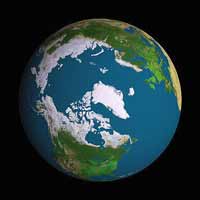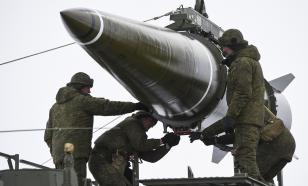Ozone hole saves Earth’s ice caps
It is an open secret that ice caps of the Earth are quickly diminishing in size. Scientists calculated to which extent the surface of the World Ocean will rise if ice of high latitudes melts completely. Scientific forecasts look quite pessimistic, but nobody knows how to counter the global warming. Meanwhile, scientists from the international research group that studies the state of polar ice of the Arctic and the Antarctic found that there is a factor that saves these areas for the time being. Surprisingly, it is the ozone hole that prevents the quick melting of the Antarctic. Two decades ago the ozone hole was regarded as the major threat to the biosphere of the planet.

Climatologists and oceanologists from the UK, the USA and Sweden concluded that Antarctica resists the warming better than the Arctic does. According to them, the North Pole is getting warmer much quicker than the South Pole, the National Oceanic and Atmospheric Administration (NOAA) said. Thus, in the regions of eternal ice in the Northern Hemisphere seasonal temperatures may be four degrees Fahrenheit (a bit more than two degrees Celsius) lower than the average, but in the most part of Antarctica there are no changes in temperature. The only exception is the Antarctic Peninsula, a strip of land along South America. There warming is even more measurable than in the Southern Hemisphere - three degrees Fahrenheit (about 1.7 degrees Celsius).
The Arctic is getting warmer for several reasons, scientists consider. James Overland from the NOAA Pacific Marine Environmental Laboratory stated that when making forecasts scientists should take into consideration the influence of greenhouse gases, the change of prevailing winds and the higher oceanic temperature. Nathan Gillett from the University of East Anglia said that in the Antarctic the picture is quite different: the change in winds and air temperatures meet the calculations that take into account both the greenhouse effect and the influence of the ozone hole above the mainland. It is the ozone hole that hinders the Antarctic warming.
A thinner layer of stratospheric ozone at a height of several dozen kilometers above the Antarctic ice causes stronger winds on this continent. It keeps cold air above the mainland and prevents the flow of warmth from the north. While the situation persists, ice will not melt. However, the hole discovered in the mid-1980s is not eternal: the ozone layer is gradually restoring above the South Pole. On the one hand, it helps to protect the Earth from solar radiation, but on the other hand, it means that the last warming-preventing factor will not work, scientists consider. Different calculations suggest that the hole is due to disappear by 2050-2070. If temperatures continue to increase, the eternal ice of the Southern Hemisphere will melt much faster.
However, forecasts for the north polar cap are much more pessimistic. The square of pack ice decreases every year, and the situation with the ozone hole is much better in our hemisphere than above Antarctica. For example, last September the Envisat satellite took an image of another anti-record: due to the melting ice the first north-western passage opened for the first time from the Atlantic into the Pacific Ocean around North America. The total square of arctic ice amounted then to three million square kilometers.
The situation is not better in seas that wash the north of Europe. This winter saw another record-small square of ice in the Baltic region. According to Sweden’s meteorological agency, about 49,000 square kilometers froze there during 2007-2008 (the norm is 180,000). The record glaciation was marked in the winter of 1986-1987 when ice covered 420,000 square kilometers. This year even the Gulf of Bothnia between Sweden and Finland did not practically freeze, only near the shores. To crown it all, the Baltic Sea unfroze completely two weeks earlier than usual.
Experts feel pessimistic about the forthcoming winter as well. According to James Overland, the Arctic will repeat last year’s record. Now the square of frozen seas in the Northern Hemisphere is 40 percent lower than it was two decades ago. “Last autumn, winter and up till now the concentration of ice in the Arctic is below norm,” the Associated Press quoted Jennifer Francis from the University of Rutgers as saying.
Translated by Julia Bulygina
Pravda.ru
Subscribe to Pravda.Ru Telegram channel, Facebook, RSS!


